|
|
|||
|
RUFOUS HUMMINGBIRD |
|
All text & photos © Hilton Pond Center After a successful morning trip on which we banded Rufous Hummingbirds in Spartanburg SC and Columbus NC, we returned to Hilton Pond Center on the afternoon of 22 December 2003--only to find an E-mail message that yet another winter hummer was coming to a feeder at Landrum SC (Spartanburg County). Nonetheless, on the 22nd we immediately contacted Nan Keenan-VanLaan, who with husband Jim had been hosting a vagrant hummingbird in Landrum since mid-October. Nan had just read in the Tryon Daily Bulletin an account of a Rufous Hummingbird we banded on 29 November in Tryon NC, just west of Columbus. Realizing from the article that the Landrum hummingbird had potential scientific value, she was eager to have her bird banded, too, so she invited us to drive back up I-26 for an early morning trapping attempt on 23 December.
We got to Landrum before 7 a.m., but because of heavy clouds the skies were still quite dark. Following our usual procedure, we hung our portable hummingbird trap and moved the VanLaans' feeder into it, securing the whole mechanism on a shepherd's crook outside the kitchen window. The skies began to lighten by 7:15 a.m., and--true to our expectations--a hummingbird came into view about ten minutes later. The bird perched in a nearby grape arbor and then made several trips to the feeder without figuring out how to get its morning hit of sugar water. Finally, at 7:40 a.m., the hummer entered the trap, and we quickly hit the remote button, instantly dropping a sliding door behind the bird.
As the hummer hovered in the trap, we could see that the base of its tail was somewhat rusty--an indication it was either a Rufous (Selasphorus rufus) or Allen's Hummingbird (S. sasin). By this time of the year, the absence of any rust on the back indicated it likely was a female, but the species and age could only be determined from in-hand examination. We carried the newly captured hummer indoors to take its measurements (see below); After we measured and banded the bird, Nan took it from us and held it carefully in her hand--making note of the hummer's warmth and respiratory activity. Upon release the Landrum hummer flew skyward and disappeared, but--according to Nan-- was seen again at the feeder every day from 24 December at least until this account was posted five days later.
Vital Statistics for
All text & photos © Hilton Pond Center
If you're interested in sharing your hummingbird observations and learning from other enthusiasts, you may wish to subscribe to Hummingbird Hobnob, our Yahoo!-based discussion group. Also be sure to visit our award-winning Web site for Operation RubyThroat: The Hummingbird Project; on it you'll find almost anything you want to know about hummingbirds, including more information about Hummingbird Banding.
For much more information about hummingbirds, visit Operation RubyThroat: The Hummingbird Project 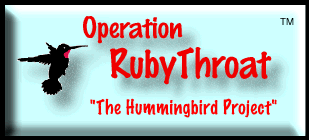 |
|
Make direct donations on-line through
Network for Good: |
|
|
LIKE TO SHOP ON-LINE?
Donate a portion of your purchase price from 500+ top on-line stores via iGive: |
|
|
Use your PayPal account
to make direct donations: |
|
 post questions for The Piedmont Naturalist |
Join the |
Search Engine for |
|
|

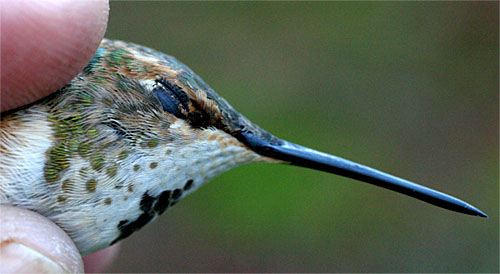
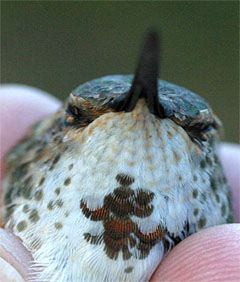 This was a bit ironic because Landrum is the LAST exit in South Carolina as one drives north on I-26, and Columbus is the FIRST exit inside North Carolina. Had we known in advance, we could have swung by Landrum on the way back from Columbus and had a three-bird day.
This was a bit ironic because Landrum is the LAST exit in South Carolina as one drives north on I-26, and Columbus is the FIRST exit inside North Carolina. Had we known in advance, we could have swung by Landrum on the way back from Columbus and had a three-bird day.

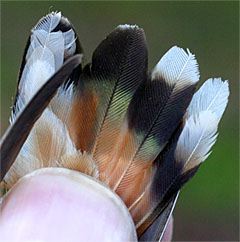 since a Rufous is somewhat bigger than an Allen's, the relatively long tail chord and wing lengths--along with the width of the outer tail feather--allowed us to conclude that it was indeed a female Rufous. Because nearly 60% of the length of the bill bore tiny etchings, we also knew it was a bird that hatched in 2003, despite its large number of iridescent throat feathers. (The bill of an older hummingbird is essentially smooth from base to tip, and older females usually have more metallic gorget feathers.)
since a Rufous is somewhat bigger than an Allen's, the relatively long tail chord and wing lengths--along with the width of the outer tail feather--allowed us to conclude that it was indeed a female Rufous. Because nearly 60% of the length of the bill bore tiny etchings, we also knew it was a bird that hatched in 2003, despite its large number of iridescent throat feathers. (The bill of an older hummingbird is essentially smooth from base to tip, and older females usually have more metallic gorget feathers.)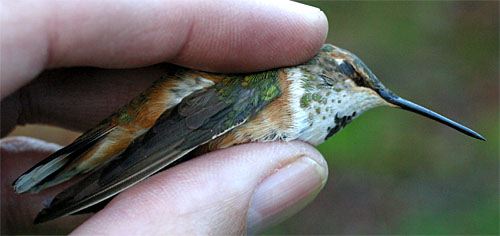
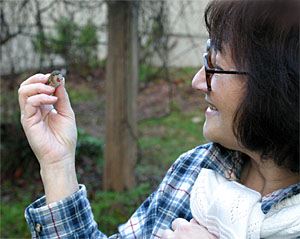

 Students at GLOBE-certified schools may submit winter hummingbird observations as part of Operation RubyThroat and GLOBE. Students can also correlate hummingbird observations with data on abiotic factors, including atmosphere, climate, hydrology, soils, land cover, and phenology. See the
Students at GLOBE-certified schools may submit winter hummingbird observations as part of Operation RubyThroat and GLOBE. Students can also correlate hummingbird observations with data on abiotic factors, including atmosphere, climate, hydrology, soils, land cover, and phenology. See the 

